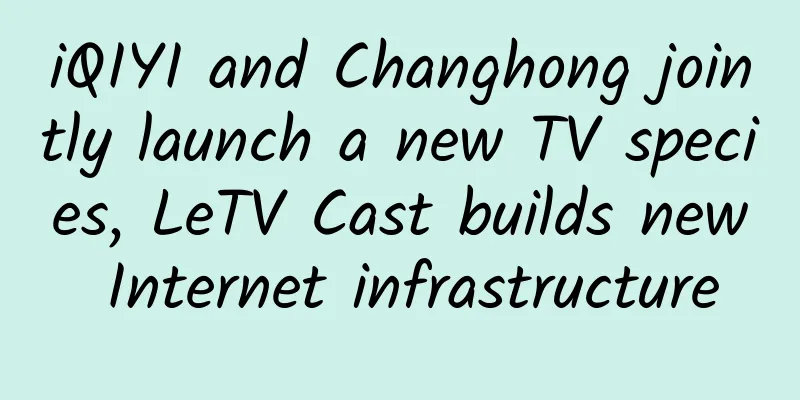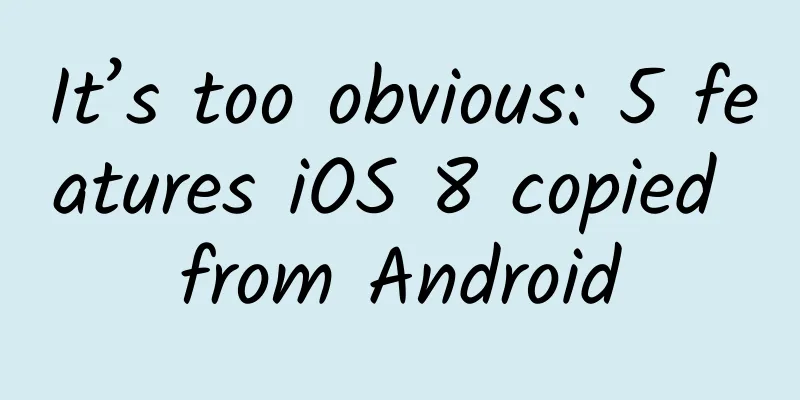iQIYI and Changhong jointly launch a new TV species, LeTV Cast builds new Internet infrastructure

|
As home appliances continue to become smarter, smart TVs are becoming more and more prominent in the IoT system. However, as content consumption devices, smart TVs are losing ground in the battle for user time. The reason is that mobile phones have left TV platforms behind due to the massive iteration of content platforms. How can TV catch up with the rapid progress of mobile Internet? Reinventing the wheel is not the most effective way. In this era, more and more smart TV manufacturers are turning their attention to "screen projection". Recently, Changhong and iQiyi jointly launched a new species in the smart TV industry - Kiwi AI Casting TV, actively embracing the mobile Internet, seamlessly linking mobile phone content to the large screen in the living room, and bringing more gameplay to mobile phone-TV. Smart TV wins the market but loses users It is undeniable that smart TV, as an Internet device that is permanently present in the home, has both high performance and a large screen, and is recognized as the best smart home hub carrier. Compared with mobile phones, smart TVs have a more immersive large screen and powerful sound effects, making them a more ideal film and television entertainment terminal in the home. As a result, smart TV products have indeed been favored by the market. By the end of 2019, China had 270 million smart TVs, covering 210 million households and 630 million users. However, behind the impressive sales figures, smart TVs are gradually drifting away from users. Data released by CSM shows that the average daily usage time of smart TVs reached 164 minutes in 2012, but by 2019, this number had dropped to 117 minutes. The reason is obvious. With the rapid development of mobile Internet, the content field of smartphones has long experienced a shift from long videos to medium and long videos, and then to short videos. Users have also developed many habits such as socializing, learning, and playing games on small screens. In comparison, smart TVs that stick to the long video track seem a bit bland, and eventually turn themselves into "background music artifacts" for the elderly. In fact, smart TVs and mobile Internet are not opposite ends. They both belong to the same Internet ecosystem, but there is a lack of a "bridge" between them. "Screen projection" is the best shortcut to cross this gap. It allows mobile Internet content to be seamlessly transmitted to the smart TV platform, broadens the platform boundaries of smart TVs, and effectively attracts young and high-value users to return to the large-screen platform in the living room. Smart TV screen projection has become a major trend For many geek users, the concept of screen projection is not new. They have already been familiar with technologies such as Apple iOS's AirPlay, Android's MiraCast, DLNA, ChromeCast, etc. Among TV manufacturers, even Sony, which is most known for its maturity and prudence, cooperated with LeTV during the 618 period this year to launch the Sony U8G TV with "screen projection" as its selling point. Unfortunately, it is still too idealistic to expect users to return to the living room simply by projecting or mirroring content from their mobile phones to a large TV screen. How to find more practical scenarios for smart TVs and screen projection is a common problem faced by the entire industry. On September 17, JD Home Appliances held an industry conference with the theme of "Reconstructing the Value of TV", inviting upstream and downstream participants in the smart TV industry to discuss the future of the smart TV industry. During the meeting, JD Black Electronics pointed out two channels for the smart TV industry based on industry big data - education and games. Against the backdrop of the epidemic, the value of Internet education has become more prominent. Large-screen learning is conducive to the presentation of teaching content and is also more friendly to vision. According to data from China Research and Development Institute, including multiple online education markets such as K12 education, higher education, and adult education, China's distance education already had a market size of 414 billion yuan in 2019, which has the potential to provide smart TVs with a broader value space. In terms of games, in 2019, large-screen TV console games accounted for 48.8% of the North American game market. This figure is only 0.3% in China where mobile games are rampant. There is huge room for imagination in the domestic living room game market. Education and games are also living room scenarios where screen projection technology is extremely good. Many online course software and games do not have TV versions, and screen projection has become the hammer that breaks the platform barriers. TV terminal manufacturers have obviously also keenly noticed this. In its new species, projection screen TV, Changhong specifically emphasized the many new functions that projection screen can bring that fit the usage scenarios. In the view of LeTV, the leader in the screen projection industry, in addition to subverting the past screen projection experience of long and short videos and expanding the new frontier of game education, the openness of the screen projection platform is the key to the future market success. For example, LeTV's open platform allows mobile game apps to project game images to the TV screen, while displaying maps and operating buttons on the mobile phone, realizing multi-screen interactive functions similar to Nintendo's WiiU game console. In addition, educational mobile apps can project course content to the large TV screen, while allowing users to interact with teachers on the mobile phone by answering questions and asking questions. In long video screen casting, LeTV users can not only use the remote control to control the playback, but the screen casting can also support automatic video continuation. LeTV has made screen projection an ecosystem and created countless ways to play with it. It should be said that the cooperation between Changhong and iQiyi to launch smart TVs with screen projection as a selling point is a wise choice made by the TV industry after sensing the trend. LeBo Ecosystem builds new infrastructure in the Internet era "Connection" is the eternal theme of the Internet era, and smart TV is a core hardware product at the center of the vortex of the Internet and Internet of Things era. It not only bears the heavy burden of connecting IoT devices, but is also one of the most important outlets for Internet content. At a time when smartphones have captured a large amount of users' time and cultivated their mobile Internet usage habits, screen projection is undoubtedly the best shortcut to acquire users on smart TVs. It is precisely because of this that LeTV Cast, which was founded in 2013, has been able to take steady steps and gradually become an important link in future-oriented connections in the entire Internet ecosystem. LeTV's newly launched LeTV Open Platform Service is based on the openness and extensibility of the LeTV Protocol. It uses LeTV's unique split-screen mirroring technology, dynamic loading technology, and large-screen underlying adaptation technology to open its arms to more APPs and help APPs achieve more innovative functions. In addition, LeTV Open Platform also supports rich media display capabilities; supports APP push of various rich media information such as barrage and comments to the large-screen display to enrich the user experience; supports mobile APP push capabilities. By accessing the LeTV Open Platform, there is no need to independently develop a large-screen APP. The mobile APP can be pushed to the large screen. After pushing, users can independently operate the APP on the large screen to achieve automatic continuation of recommended content, content selection, etc. In addition, LeTV Open Platform also supports commercial advertising service capabilities, opening up various forms of advertising and independent advertising monitoring services for APPs, helping APPs to create an advertising platform that combines brand and effect. Changhong is certainly not the first color TV brand to "take a fancy to" screen projection technology, and iQiyi is obviously not the only APP that likes screen projection. In fact, LeTV has already built a huge content-platform ecosystem. According to LeTV's official introduction, LeTV Cast has covered 95% of TV/projector/box brands on the market. Domestic mobile phone brands such as Xiaomi, OPPO, vivo, Hammer, Nubia, etc. have embedded LeTV SDK. More than 3,000 mobile apps such as Kuaishou, Xigua Video, Bilibili, and Toutiao have cooperated with LeTV. It can be said that with the bridge of screen projection, smart TVs no longer have any content shortcomings compared to mobile devices. With the empowerment of LeTV's open platform, mobile phones and large screens can even be combined with more creative gameplay and realize more functions. The full connection between the two platforms can also bring more imagination space to the smart TV and smartphone industries. Not only that, by opening up the screen projection technology between smartphones and smart TV platforms, LeTV can not only help smart TV platforms win back users, but also provide a new perspective for the industry, using cross-platform advertising service capabilities to bring wider traffic channels and broader value space to all three parties. On the road to the new frontier of television, such as education and gaming, screen projection has given smart TVs a ticket to the center of the era. In addition to the inherent territory of smartphones, it has opened up two new battlefields by relying on the advantages of large screens and screen projection technology, creating a bright enough prospect for the future of the industry. Today's screen projection technology is increasingly becoming another infrastructure of the Internet era. Almost all TVs, mobile phones, and mobile apps regard it as a standard configuration. As an advocate of the value of screen projection and a builder of the screen projection ecosystem, LeTV Screen Projection will surely derive more and more practical and intelligent scenarios in the Internet and Internet of Things ecosystems, continue to create value for users, and build a new infrastructure for the Internet ecosystem. As a winner of Toutiao's Qingyun Plan and Baijiahao's Bai+ Plan, the 2019 Baidu Digital Author of the Year, the Baijiahao's Most Popular Author in the Technology Field, the 2019 Sogou Technology and Culture Author, and the 2021 Baijiahao Quarterly Influential Creator, he has won many awards, including the 2013 Sohu Best Industry Media Person, the 2015 China New Media Entrepreneurship Competition Beijing Third Place, the 2015 Guangmang Experience Award, the 2015 China New Media Entrepreneurship Competition Finals Third Place, and the 2018 Baidu Dynamic Annual Powerful Celebrity. |
Recommend
How to advertise on public accounts? Case Analysis
The number of advertisements placed on official a...
The first wide-body coupe: 2018 Volkswagen Lingdu review
Shanghai Volkswagen defines Lingdu as the "f...
Brand promotion: a reusable traffic methodology
As you all know, some methods of tapping into tra...
GAC Trumpchi GA4 is coming soon, and Lavida is not calm
GAC Trumpchi's new compact sedan GA4 was offi...
Google launches new Qaya service: Help creators easily build online stores
The new project, Qaya, co-founded by Nathaniel Na...
A brief analysis of the content marketing strategy of Li Ziqi, the “first internet celebrity with ancient style”!
• Introduction• Explore the value behind the IP o...
It has just been announced that the LPR has been lowered, your mortgage may become cheaper!
Mixed Knowledge Specially designed to cure confus...
Interesting facts about the Spring Festival travel rush | How do you get a train driver's license? Is it also subject 3?
Original title: "Ask the reporter·Fun facts ...
If you want to do community group purchasing, how do you solve the supply problem?
In 2020, community commerce is developing in full...
Two cars collided and caught fire in a high-speed tunnel. The surveillance showed the details of the accident... Please drive carefully!
At 17:05 on August 3, two vehicles collided and c...
iOS15 Beta5 update, many new improvements, but not recommended
The update package is 6.0.5GB, which may vary sli...
A brief analysis of the private domain traffic growth model!
Today, the reason why fission is so popular is th...
Goldene, only one atom thick, was created for the first time! How difficult is it to create two-dimensional materials?
Author: Chen Jiajun I believe many people have he...
Why are mobile phones getting heavier nowadays?
Nowadays, we use mobile phones more and more freq...
How to formulate corresponding promotion strategies in the three stages of APP?
What is operation? I have read a sentence in &quo...









